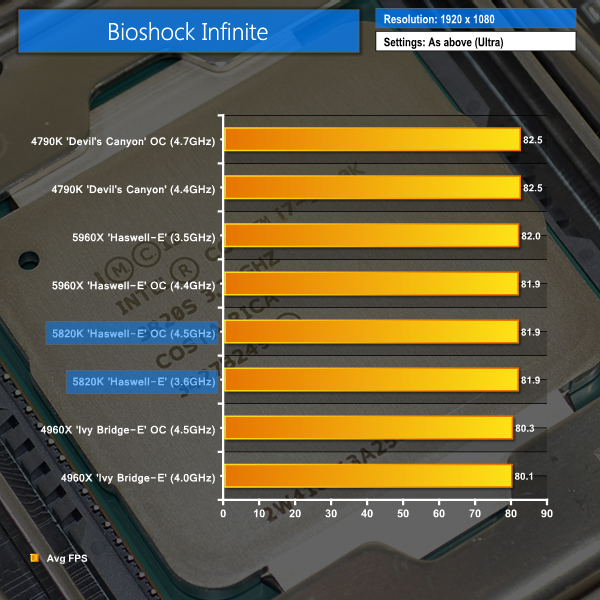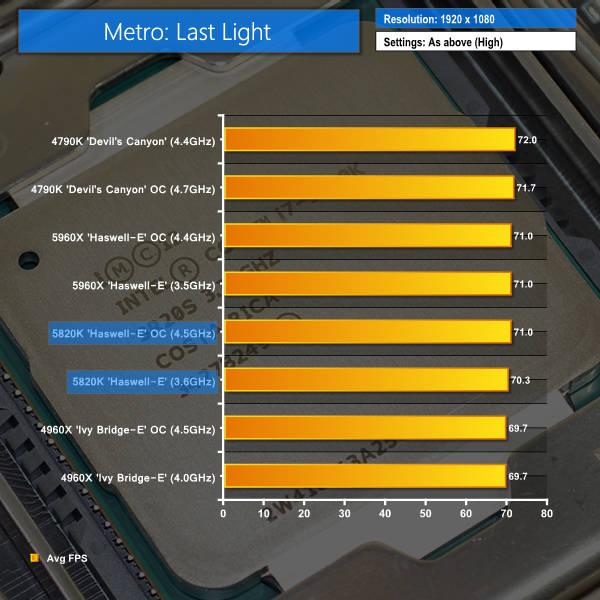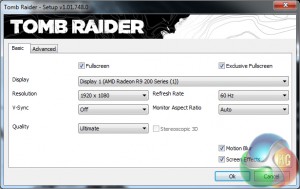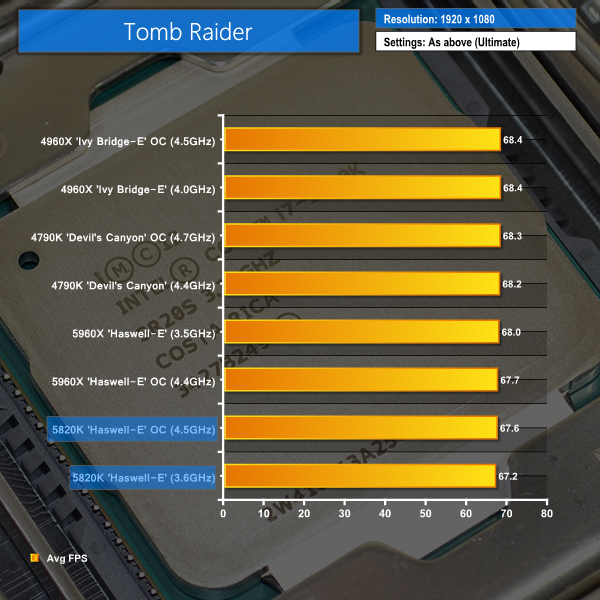Bioshock Infinite
We used the Bioshock Infinite demanding ‘Ultra’ setting and a 1920×1080 resolution to push today’s hardware. Our data was recorded using a section of the game, not the built-in benchmark.
Metro: Last Light
We used a 1920×1080 resolution and the Metro: Last Light built-in benchmark set to ‘High’ quality to offer an intense challenge for the hardware while also making playable frame rates a possibility.
Tomb Raider
We used a 1920×1080 resolution and the Tomb Raider built-in benchmark set to ‘Ultimate’ quality.
Our gaming tests all use a 1920×1080 resolution for the purpose of a realistic usage environment. While the 2 Megapixel image being rendered weighs heavily on GPU performance (almost negating CPU specification advantages in many cases), anything lower than 1920×1080 is simply non-representative of a gaming environment likely to be used with these chips.
In all honesty, an even higher test resolution would have been justifiable, given the processing power on show. The deciding factor was the 1920×1080 resolution's unparalleled market share, which dwarfs all other pixel configurations.
Be it at stock or overclocked speeds (which are both very close), the Devil's Canyon 4790K takes both top spots in the Bioshock Infinite and Metro: Last Light gaming tests. This is still difficult to explain, especially with the Haswell-E parts offering similar frequencies (when overclocked) and more cores and cache.
My best attempt at an explanation would be that the Z97 platform is to thank for minute frame rate differences. The back-to-back results for each chip in its stock and overclocked state acts as additional validation for the beneficial platform point.
Our data would suggest that Tomb Raider rewards greater memory performance with a few extra tenths of a frame. The high-latency DDR4 systems drop to the bottom spots, while Ivy Bridge-E and Devil's Canyon's fast and tight DDR3 kits give them the extra fractions needed for top-half finishes.
With all that said, the grouping for Haswell-powered processors remains within a tight ~0.7% for Bioshock Infinite, ~2.4% for Metro: Last Light, and ~1.6% for Tomb Raider. If you are only concerned with gaming, and do not need more than two-way SLI or CrossFire, the money saved by purchasing a 4790K will be better spent on increased graphics horsepower. We are hoping to look at other resolutions in the future to see if that suggestion remains consistent.
 KitGuru KitGuru.net – Tech News | Hardware News | Hardware Reviews | IOS | Mobile | Gaming | Graphics Cards
KitGuru KitGuru.net – Tech News | Hardware News | Hardware Reviews | IOS | Mobile | Gaming | Graphics Cards










MKV is not a video format, it is a container. What format was the video in for the conversion? Odds are it was already an MP4 encoded using H.264 which was Stored as a stream inside the MKV file – meaning your test was just resampling the original file and not really encoding anything.
You are correct. As suggested, the file uses an MPEG-4 part 10 (H.264) codec and is simply contained within the MKV container. The operation being run is more of a remuxing process than an encode – it takes the H.264 video out of a MKV container and puts it into a MP4 container.
The test results are still perfectly valid and highlight differences in processing power. I will look into a ‘true’ encode test for future usage.
Well, a couple things about video encoding you should probably take into account. 1) Your using Handbreak, which uses Gstreamer, which doesn’t natively use Intel’s Quick Sync Video – but it does Use VCE (the Radeon 280x in your test build supports VCE) 2) so while you where testing the processors ability to pass information along, you won’t actually be testing the SIP components on the Processors unless you use a program that fully utilizes the Gen2 and Gen3 Intel Quick Sync technologies in the IB-E or the Haswell.
So unless you use a program that isn’t routing directly through the video card, you won’t actually be testing the processor with video encoding.
But the issue is that QuickSync doesn’t exist on the platform LGA2011, that is part of the platform 1155/1150 as they have their GPU builtin on the die, unlike the LGA2011 counterparts.
One of the processors being compared here (the 4790k) has Intel Quick Sync. just because the 5820k doesn’t, doesn’t mean the tests used shouldn’t support it. I was also bringing up the fact that any transcoding done on this specific build will utilize the GPU’s video encoding technology and not really be a true representation of the CPU’s encoding ability.
Could somebody help me pls?
I have a sabertooth z97 mark 1 and it is supposed to run 5th gen processor (updating it), but the thing is that the socket the mother has is an 1150 and I see the 5th gen are lga 2011 or 2011-v3. Here comes my question.
After my BIOS is upgraded it’s supposed to work with the lga 2011 processors?
my i7 5820k at stock speeds idles at around 29 degrees celcius with an h100i and all case fans at max. is that ok???
That’s typical, provided the ambient temperature is in the low 20s. Mine’s currently at 4.5ghz idles around 33c with a custom loop
Denise, I imagine you’ve gotten the answer to this question by now, but the 1150 and the 2011 sockets are unfortunately physically different so a BIOS update will not let you use any of the Haswell-E CPU’s in the 1150 socket.